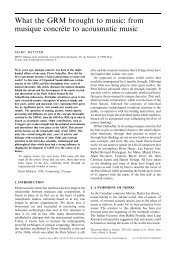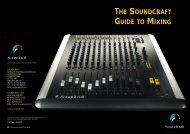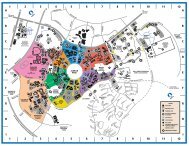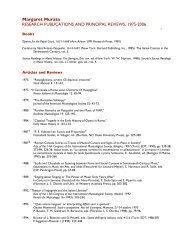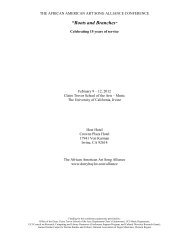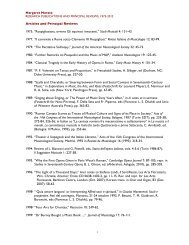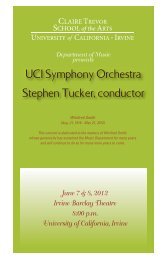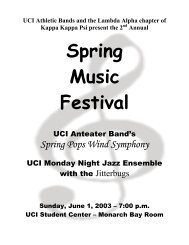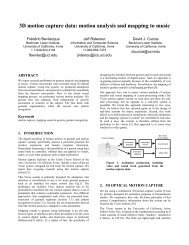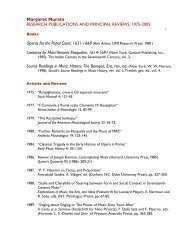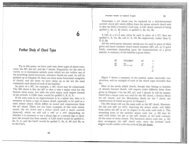amy bauer The Other of the Exotic: Balinese Music as Grammatical ...
amy bauer The Other of the Exotic: Balinese Music as Grammatical ...
amy bauer The Other of the Exotic: Balinese Music as Grammatical ...
You also want an ePaper? Increase the reach of your titles
YUMPU automatically turns print PDFs into web optimized ePapers that Google loves.
<strong>The</strong> <strong>O<strong>the</strong>r</strong> <strong>of</strong> <strong>the</strong> <strong>Exotic</strong> 361<br />
Ex. 15 ‘Galamb borong’, transformation network <strong>of</strong> countersubject (CS),<br />
bars 3–33<br />
Right hand<br />
3 5 10 15 20 25 30<br />
I8<br />
I10<br />
T10<br />
T8<br />
T10<br />
I8<br />
MT CS CS CS CS CS CS CS<br />
tail<br />
I 5<br />
T 7<br />
T9 I 5 T7<br />
T3<br />
T 3 T 1 T 9 T 1 T 7 I3<br />
T 9 T 1 T11 I 7<br />
CS<br />
CS<br />
T4 I0 I2 T4 T10 I 8 I 0 T0<br />
CS CS<br />
CS CS<br />
CS CS CS<br />
CS<br />
Left hand<br />
‘Galamb borong’ is a subtle parody <strong>of</strong> both <strong>the</strong> virtuoso étude and <strong>the</strong> oriental<br />
character piece; yet it h<strong>as</strong> for <strong>the</strong> most part transcended satire to enter <strong>the</strong><br />
contemporary canon with nothing more than a sly wink. <strong>The</strong> virtuoso étude is<br />
well represented by this highly demanding and showy work, which utilises <strong>the</strong><br />
entire pitch and dynamic range <strong>of</strong> <strong>the</strong> modern piano and requires <strong>the</strong> pianist to<br />
apply different levels <strong>of</strong> dynamics, articulation and rhythmic organisation to two,<br />
three or four voices simultaneously. <strong>The</strong> counterpoint noted in Section 1 is<br />
certainly a familiar procedure for structuring a toccata-like work or character<br />
piece, in which short, recognisable motives in transposition and inversion replace<br />
legato melody and clearly demarcated formal sections. As a fur<strong>the</strong>r guide<br />
through this network <strong>of</strong> motivic <strong>as</strong>sociations, transformational graphs are provided<br />
for <strong>the</strong> primary motives in Section 1.<br />
<strong>The</strong>se motives travel predominantly by a level <strong>of</strong> transposition (T n ) <strong>of</strong> interval<br />
cl<strong>as</strong>s 10 in <strong>the</strong> hands, towards and away from <strong>the</strong> ‘normative’ or stable T 3/9<br />
relation between <strong>the</strong> right and left hands. Each motive transforms by characteristic<br />
transpositions and inversions (I), which move away from <strong>the</strong> relatively stable<br />
beginning <strong>of</strong> <strong>the</strong> work to produce contrapuntal and ‘harmonic’ motion. I will first<br />
examine <strong>the</strong> progress <strong>of</strong> <strong>the</strong> countersubject, which, like descending scales<br />
throughout Ligeti’s oeuvre, permeates <strong>the</strong> texture and provides a constant source<br />
<strong>of</strong> dynamic tension. Ex. 15 includes only those appearances <strong>of</strong> <strong>the</strong> countersubject<br />
in <strong>the</strong> outer voices <strong>of</strong> bars 1–33 (including one instance <strong>of</strong> <strong>the</strong> countersubject<br />
in concert with itself, bars 13–14). Two scale degrees, ˆ3 and ˆ4, predominate in<br />
both hands (A/C and B/D respectively) in order to reinforce <strong>the</strong> opening notes<br />
<strong>of</strong> <strong>the</strong> core melody and <strong>the</strong>ir prolonged descent. <strong>The</strong> T 7 relation introduces<br />
‘harmonic progression’ by sequencing <strong>the</strong> countersubject at <strong>the</strong> fifth, while <strong>the</strong> I 5<br />
relation introduces <strong>the</strong> ‘consequent’ <strong>of</strong> <strong>the</strong> opening phr<strong>as</strong>e with rising scales in<br />
four registers (bars 10–15). As <strong>the</strong> section proceeds, both hands alternate<br />
<strong>Music</strong> Analysis, 27/ii-iii (2008)<br />
© 2009 <strong>The</strong> Author.<br />
Journal compilation © 2009 Blackwell Publishing Ltd.



